IN00195 Ramtek Inscription of a Daughter of Prabhavatigupta
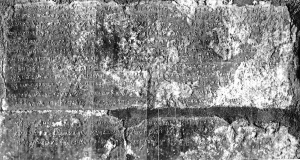
Memorial stone inscription discovered during cleaning undertaken by the Directorate of Archaeology and Museums, Maharashtra Government in the early 1980s. The inscription is carved onto stones fixed on the inside wall of the mandapa of the Kevala-Narasiṃha temple at Ramtek. The inscription records a pious action of an unidentified daughter of Prabhāvatī Guptā, during the reign of her brother Pravarasena II. However the inscription is damaged and a clear reading is not possible at this point in time.
IN00194 Bidar Charter of Devasena
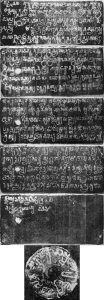
The location of the original five copper plates and their ring are no longer known, but iron reproductions of the plates were created by a Bidri worker in Bīdar when the plates were brought to him by a villager from the Bechchali tālukā of the Bīdar district. Although the original plates are untraceable, the iron copies give an accurate copy of the charter which records Devasena’s donation of the village of Velpakoṇḍā in ‘favour of one Raddochha, a scholar of the four Vedas’ (Shastri 1997: 108). The inscription was issued from Vatsagulma. According to Shastri (1997: 109), this is the only known complete official grant of Devasena. Shastri (1997: 110) also argues that this plate is important because it may prove that the Vatsagulma branch of the Vākāṭakas spread into Karnataka, as the ending of the named village in the inscription may suggest.
IN00193 Thalner Charter of Harisena
The Thālner copper plates, which consist of three inscribed copper plates with a ring, were acquired from a resident of Thālner by a blacksmith from Dhule. The plates date to the third year of Hariṣeṇa’s reign and are the only known official charter of the king, who was the last ruler of the Vatsagulma branch of the Vākāṭakas. The plates record the donation of two villages and some land to a group of Brāhmaṇas who were students of Sāmaveda.
IN00192 Hisse-Borala Inscription of Devasena


The four lined stone inscription was first published in 1963-64. It was discovered in what is considered to be a wall of ancient bricks which appear to have made a dam near the village of Hisse-Borālā. The inscription, which is dated to the reign of Devasena, contains a reference to the Śaka year 380 (i.e. A.D. 458-59), which is the earliest known reference to the Śaka era within the Vidarbha region. The inscription records the construction of a tank called Sudraśena by Svāmilladeva, an officer of Devasena.
IN00191 Mahurjhari Charter of Prthvisena II, Year 17

This set of 5 copper plates dating to the reign of Pṛithivīṣeṇa II, were discovered in June 1971 in a field during ploughing. The field was owned by Shri Borkar who, at that time, lived in the village. The village, according to V. B. Kolte (1972: 183), is an ancient site with many archaeological remains dating to the Vākāṭaka period. There are also stone circles which date as far back as 3000 years suggesting continued habitation throughout this period. This is one of the only known copper plate charters of Pṛithivīṣeṇa II which is complete. The charter was issued in the king’s 17th year of rule and records the grant of the village Jamalakheṭaka to the Brāhmaṇas Vishṇudatta and Bhavadatta, residents of Pṛithivīpura, from where the charter was issued.
IN00190 Mandhal Charter of Prthivisena II, Year 10
This set of five copper plates were discovered during archaeological excavations undertaken at Māṇḍhaḷ by the Department of Ancient Indian History, Culture and Archaeology, Nagpur University. These plates were discovered with two other Vākāṭaka copper plate charters (IN00183 and IN00189). Each charter was complete with ring and seal attached. This charter, inscribed on four plates, records the donation of the village Govasāhikā to four Brāhmaṇas, including two – Maheśvarasvāmin and Brahmasvāmin – who are also mentioned in the Māṇḍhaḷ copper plate charter of Pṛithivīṣeṇa II, year 2 (IN00189). Shastri (1997: 99-103) argues that the three plates found at this site record donations by two Vākāṭaka kings to two generations of the same family.
IN00189 Mandhal Charter of Prthivisena II, Year 2
The charter consists of four plates, which were found in an earthen vessel during excavations, along with two other Vākāṭaka period copper plate inscriptions. The charter was issued in the second year of Pṛithivīṣeṇa II’s reign and was found complete with ring and seal, providing the earliest known complete example of a copper plate charter from the reign of Pṛithivīṣeṇa II. The charter records the donation of the village Kurubhajjaka by its chief to three brothers, Maheśvarasvāmin, Agnisvāmin and Brahmasvāmin, sons of Māṭrisvāmin. Two of these brothers are also the benefactors of the Māṇḍhaḷ copper plate of Pṛithivīṣeṇa II, year 10 (IN00190) and Māṭrisvāmin was the donee of the Māṇḍhaḷ copper plate of Pravarasena II, year 17 (IN00183).
IN00188 Pauni Charter of Pravarasena II
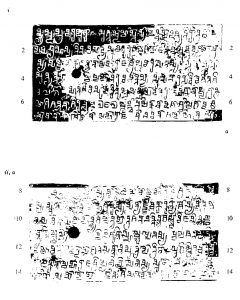
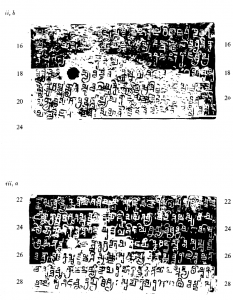
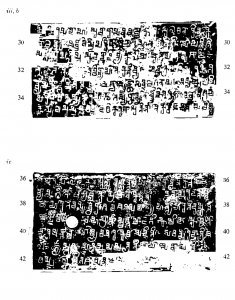

The set of four copper plates was discovered by Shri Ramchandra Narayan Wakadiker whilst digging in the ramparts of Paunī. The charter was issued from Pravarapura and records the donation of land measuring 50 nivarttanas by royal measure to Duggāryya, a student of the Ṛigveda and part of the Aupamanyava gotra. According to the inscription the land is located in the ‘holy place of Achalapuka’ and was given in exchange for another plot of land. The grant was issued in the 32nd year of Pravarasena II’s reign and provides the last date for the rule of Pravarasena II, showing that he ruled at least 32 years.